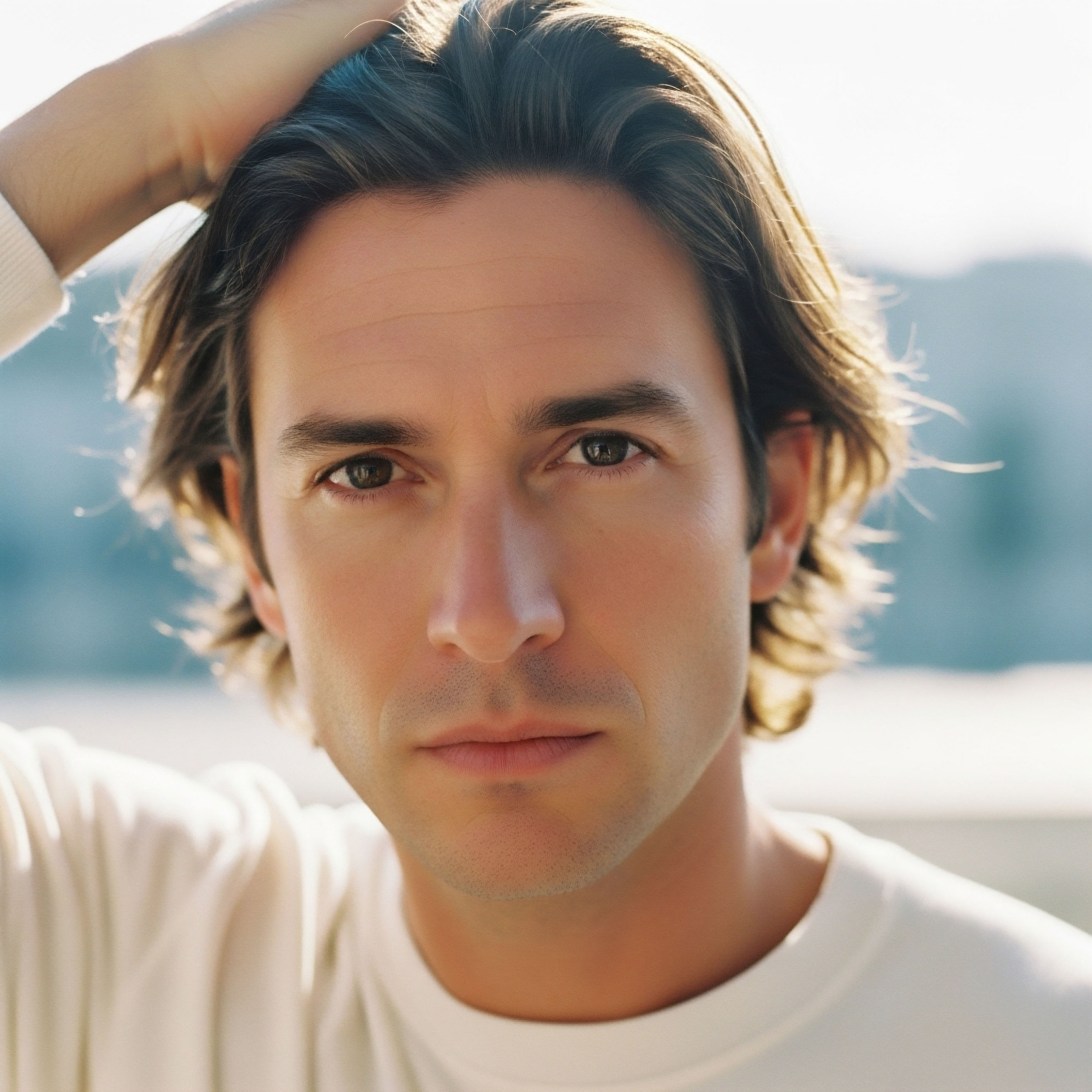

Fundamentals
Have you found yourself pushing harder in your training, yet feeling a persistent drain on your vitality, a subtle erosion of your drive, or a general sense of being “off”? This experience, often dismissed as mere fatigue or the natural consequence of an active lifestyle, can signal a deeper conversation occurring within your biological systems.
Your body communicates through an intricate network of chemical messengers, and when this communication becomes strained, the effects ripple across your entire well-being. Understanding these internal signals marks the initial step toward reclaiming your energetic self.
The human body operates on a principle of delicate balance, particularly concerning its endocrine system. Hormones, these powerful chemical communicators, orchestrate nearly every physiological process, from mood regulation to metabolic function and physical strength. When we engage in physical activity, especially with consistent intensity over extended periods, we initiate a series of adaptations.
These adaptations are generally beneficial, promoting cardiovascular health, muscle development, and improved mood. Yet, when the demands of exercise exceed the body’s capacity for recovery, what was once a beneficial stimulus can become a chronic stressor, placing undue strain on these very systems.
Persistent fatigue and diminished drive, despite consistent exercise, can indicate a deeper imbalance within the body’s hormonal communication network.

The Body’s Internal Messaging System
Consider your hormonal system as a sophisticated internal messaging service, constantly sending and receiving signals to maintain equilibrium. Key players in male hormonal health include testosterone, a primary androgen responsible for muscle mass, bone density, libido, and mood, and cortisol, often called the “stress hormone,” which helps regulate metabolism and inflammation.
These two hormones, among many others, exist in a dynamic relationship. When one system is overtaxed, it inevitably influences the others, creating a cascade of effects that can manifest as the symptoms you might be experiencing.
Chronic exercise, particularly high-intensity or high-volume training without adequate recovery, can significantly alter this delicate hormonal interplay. The body interprets such sustained physical exertion as a form of stress, prompting an adaptive response. Initially, this response is beneficial, enhancing performance and resilience. Over time, however, if the stress continues without sufficient periods of rest and nutritional support, the adaptive mechanisms can become dysregulated, leading to a state of imbalance rather than improved function.

Recognizing the Signals of Imbalance
Identifying when exercise transitions from a health-promoting activity to a potential hormonal disruptor requires attentiveness to your body’s subtle cues. These signals are not always overt; they often present as a gradual decline in energy, a reduced capacity for recovery, or an unexpected shift in mood. Many individuals attribute these changes to aging or other life stressors, overlooking the profound impact of their training regimen.
- Persistent Fatigue ∞ Feeling tired even after a full night’s sleep or experiencing a general lack of energy throughout the day.
- Decreased Performance ∞ A noticeable decline in strength, endurance, or overall athletic capability, despite continued training.
- Mood Shifts ∞ Increased irritability, anxiety, or feelings of apathy that seem disconnected from external circumstances.
- Reduced Libido ∞ A significant decrease in sexual interest or function.
- Sleep Disturbances ∞ Difficulty falling asleep, staying asleep, or experiencing non-restorative sleep.
These symptoms are not isolated incidents; they are often interconnected manifestations of an underlying systemic imbalance. Understanding how chronic exercise influences the intricate feedback loops of your endocrine system is paramount to addressing these concerns and restoring your optimal physiological state.


Intermediate
The impact of chronic exercise on male hormonal balance extends beyond simple fatigue, reaching into the very core of the endocrine system’s regulatory mechanisms. At the heart of male hormonal regulation lies the Hypothalamic-Pituitary-Gonadal (HPG) axis, a sophisticated communication pathway involving the hypothalamus in the brain, the pituitary gland, and the testes.
This axis functions like a precise thermostat, constantly adjusting hormone production to maintain physiological equilibrium. When chronic exercise introduces sustained stress, this finely tuned system can experience significant disruption.
Intense, prolonged physical activity, particularly without adequate recovery, can suppress the pulsatile release of Gonadotropin-Releasing Hormone (GnRH) from the hypothalamus. This, in turn, reduces the pituitary gland’s secretion of Luteinizing Hormone (LH) and Follicle-Stimulating Hormone (FSH), which are essential for stimulating testosterone production in the testes and supporting spermatogenesis. The result is often a state of functional hypogonadism, where testosterone levels decline, leading to many of the symptoms described earlier.
Chronic, intense exercise can suppress the HPG axis, leading to reduced GnRH, LH, and FSH, which ultimately lowers testosterone production.

Recalibrating the Endocrine System
Addressing exercise-induced hormonal imbalances often requires a targeted approach, moving beyond simply reducing training volume. Personalized wellness protocols aim to recalibrate the endocrine system, restoring its innate intelligence and function. For men experiencing symptoms of low testosterone, Testosterone Replacement Therapy (TRT) is a well-established clinical protocol designed to restore physiological levels of this vital hormone.

Testosterone Replacement Therapy for Men
TRT protocols are not one-size-fits-all; they are carefully tailored to individual needs, considering symptom presentation, laboratory values, and overall health goals. A standard protocol often involves weekly intramuscular injections of Testosterone Cypionate (typically 200mg/ml). This form of testosterone provides a stable release, helping to maintain consistent levels in the bloodstream.
To mitigate potential side effects and support the body’s natural processes, TRT is frequently combined with other therapeutic agents. Gonadorelin, administered via subcutaneous injections twice weekly, is often included to stimulate the pituitary gland’s release of LH and FSH. This helps maintain natural testosterone production within the testes and preserves fertility, which can be a concern with exogenous testosterone administration alone.
Another common addition is Anastrozole, an oral tablet taken twice weekly. Testosterone can convert into estrogen in the body through an enzyme called aromatase. While some estrogen is necessary for male health, excessive levels can lead to undesirable effects such as gynecomastia (breast tissue development) or water retention. Anastrozole acts as an aromatase inhibitor, blocking this conversion and helping to manage estrogen levels.
In some cases, Enclomiphene may be incorporated into the protocol. This medication selectively modulates estrogen receptors, encouraging the pituitary to release more LH and FSH, thereby supporting endogenous testosterone production. Its inclusion depends on specific patient needs and goals, particularly for those aiming to optimize natural testicular function alongside or after TRT.
The precise combination and dosage of these medications are determined through careful clinical assessment and ongoing laboratory monitoring, ensuring the protocol aligns with the individual’s unique biochemical profile and therapeutic objectives.
How Do Exercise Protocols Influence Hormonal Therapy Outcomes?

Comparing Hormonal Support Protocols
| Protocol Component | Primary Action | Role in Male Hormonal Balance |
|---|---|---|
| Testosterone Cypionate | Exogenous testosterone replacement | Restores circulating testosterone levels, addressing symptoms of hypogonadism. |
| Gonadorelin | Stimulates GnRH receptors | Promotes LH/FSH release, supporting testicular function and fertility. |
| Anastrozole | Aromatase inhibition | Reduces estrogen conversion from testosterone, mitigating side effects. |
| Enclomiphene | Selective estrogen receptor modulator | Increases LH/FSH secretion, stimulating endogenous testosterone production. |
These protocols represent a sophisticated approach to restoring hormonal equilibrium, acknowledging the interconnectedness of the endocrine system. They aim not just to alleviate symptoms but to optimize physiological function, allowing individuals to regain their vitality and well-being.


Academic
The profound influence of chronic exercise on male hormonal balance extends to the very molecular and cellular mechanisms governing endocrine function. While acute exercise typically elicits a transient, adaptive hormonal response, sustained, high-volume, or high-intensity training without sufficient recovery can lead to a state of chronic physiological stress.
This stress response activates the Hypothalamic-Pituitary-Adrenal (HPA) axis, leading to elevated cortisol secretion, which in turn can exert inhibitory effects on the HPG axis, creating a complex neuroendocrine interplay.
The precise mechanism by which chronic exercise suppresses the HPG axis involves multiple points of regulation. At the hypothalamic level, prolonged energy deficits and systemic inflammation, often associated with overtraining, can reduce the pulsatile release of GnRH. This diminished GnRH signaling directly impacts the anterior pituitary’s ability to synthesize and secrete LH and FSH. Consequently, the Leydig cells in the testes receive insufficient stimulation, leading to a reduction in testosterone biosynthesis.
Chronic exercise can induce HPA axis activation and systemic inflammation, suppressing GnRH and subsequently reducing LH, FSH, and testosterone production.

Neuroendocrine Cross-Talk and Central Fatigue
The concept of central fatigue, a diminished drive to perform exercise originating from the central nervous system, is intimately linked to these hormonal shifts. Alterations in neurotransmitter balance, particularly involving dopamine and serotonin, are observed under conditions of chronic exercise stress.
These neurotransmitter changes are influenced by the circulating levels of hormones like cortisol and testosterone, creating a feedback loop that impacts both physical performance and psychological well-being. A sustained catabolic state, characterized by elevated cortisol and suppressed testosterone, can also lead to increased protein breakdown and impaired recovery, further exacerbating the fatigue.
What Are the Long-Term Consequences of Unaddressed Hormonal Imbalance from Exercise?
Beyond the HPG axis, chronic exercise can also influence other critical endocrine pathways. Thyroid hormone regulation, for instance, can be affected, with some studies indicating a potential for reduced T3 levels in athletes experiencing overtraining syndrome. This can further contribute to symptoms of fatigue, metabolic slowing, and impaired recovery. The intricate web of hormonal interactions means that a disruption in one area inevitably creates ripple effects throughout the entire system.

Growth Hormone Peptides and Recovery Optimization
In the context of optimizing recovery and supporting hormonal balance in active individuals, targeted peptide therapies have gained clinical relevance. These peptides work by stimulating the body’s natural production of growth hormone (GH), which plays a vital role in tissue repair, metabolic regulation, and overall vitality. Unlike exogenous GH, these peptides promote a more physiological release pattern, minimizing potential side effects.
- Sermorelin ∞ A growth hormone-releasing hormone (GHRH) analog that stimulates the pituitary to release GH. It promotes lean muscle mass, reduces body fat, and improves sleep quality.
- Ipamorelin / CJC-1295 ∞ A combination often used for its synergistic effects. Ipamorelin is a GH secretagogue, while CJC-1295 is a GHRH analog. Together, they provide a sustained, pulsatile release of GH, aiding in muscle gain, fat loss, and anti-aging benefits.
- Tesamorelin ∞ A GHRH analog primarily used for reducing visceral adipose tissue, but also contributes to overall metabolic health and body composition.
- Hexarelin ∞ Another GH secretagogue that can also have mild pro-inflammatory effects, often used for its potent GH-releasing properties and potential for tissue repair.
- MK-677 (Ibutamoren) ∞ An oral GH secretagogue that increases GH and IGF-1 levels by mimicking ghrelin. It supports muscle mass, bone density, and sleep.
These peptides offer a sophisticated approach to supporting the body’s regenerative capacities, particularly when chronic exercise has placed significant demands on the system. They represent a strategy to enhance recovery, improve body composition, and mitigate some of the catabolic effects associated with overtraining, thereby indirectly supporting overall hormonal equilibrium.
How Do Peptide Therapies Support Hormonal Resilience in Athletes?

Hormonal Markers in Chronic Exercise
| Hormone/Marker | Typical Response to Chronic Exercise Stress | Clinical Implication |
|---|---|---|
| Total Testosterone | Decreased | Reduced muscle mass, strength, libido, and mood changes. |
| Free Testosterone | Decreased | Directly impacts bioavailable androgenic effects. |
| Cortisol | Elevated (chronic) | Increased catabolism, impaired recovery, HPG axis suppression. |
| LH/FSH | Decreased | Indicates central suppression of testicular function. |
| Sex Hormone Binding Globulin (SHBG) | Increased | Further reduces free testosterone, binding available hormone. |
| IGF-1 | Decreased | Impaired tissue repair and growth, reduced anabolic drive. |
Understanding these complex interactions and the specific roles of various therapeutic agents allows for a truly personalized and evidence-based approach to restoring hormonal balance. The goal is to move beyond symptomatic relief, addressing the underlying physiological dysregulation to support long-term health and performance.

References
- Cadegiani, Flavio A. and Claudio E. Kater. “Overtraining Syndrome ∞ An Endocrine Perspective.” Frontiers in Endocrinology, vol. 10, 2019, pp. 1-12.
- Hackney, Anthony C. and Andrew G. Dunn. “The Exercise-Induced Hypogonadal Male Condition ∞ Physiological and Clinical Considerations.” Journal of Clinical Endocrinology & Metabolism, vol. 106, no. 1, 2021, pp. 1-10.
- Meeusen, Romain, et al. “Central Fatigue ∞ The Role of Neurotransmitters and the Immune System.” Sports Medicine, vol. 36, no. 10, 2006, pp. 821-839.
- Kraemer, William J. and Nicholas A. Ratamess. “Hormonal Responses and Adaptations to Resistance Exercise and Training.” Sports Medicine, vol. 35, no. 4, 2005, pp. 339-361.
- Vingren, J. L. et al. “Testosterone Physiology in Resistance Exercise and Training ∞ The Androgen Receptor and the Endocrine Response.” Sports Medicine, vol. 40, no. 12, 2010, pp. 1037-1053.
- Isidori, Andrea M. et al. “Aromatase Inhibitors in Men ∞ Effects on Gonadal Function and Bone Metabolism.” Journal of Clinical Endocrinology & Metabolism, vol. 91, no. 10, 2006, pp. 3777-3783.
- Jayaraman, S. et al. “Gonadorelin ∞ A Review of Its Use in the Diagnosis and Treatment of Hypogonadism.” Clinical Therapeutics, vol. 33, no. 11, 2011, pp. 1657-1670.
- Shoskes, Daniel A. et al. “Clomiphene Citrate and Testosterone Replacement Therapy for Male Hypogonadism.” Journal of Urology, vol. 195, no. 1, 2016, pp. 180-185.
- Sigalos, J. T. and L. I. Pastuszak. “The Safety and Efficacy of Clomiphene Citrate and Anastrozole in Men with Hypogonadism.” Translational Andrology and Urology, vol. 4, no. 2, 2015, pp. 180-186.
- Walker, R. F. et al. “Growth Hormone-Releasing Peptides ∞ A Review of Their Mechanisms of Action and Clinical Applications.” Journal of Clinical Endocrinology & Metabolism, vol. 86, no. 1, 2001, pp. 1-10.

Reflection
The journey toward understanding your own biological systems is a deeply personal one, often beginning with a feeling that something is amiss. The insights shared here regarding chronic exercise and male hormonal balance are not merely academic points; they are guideposts for introspection. Your body possesses an incredible capacity for adaptation and restoration, and recognizing the signals it sends is the first, most vital step in its recalibration.
Consider these explanations as a foundation, a starting point for a more informed conversation about your unique physiology. The path to reclaiming vitality and function without compromise involves a thoughtful, personalized approach, one that honors your lived experience while integrating precise, evidence-based clinical strategies. This knowledge empowers you to advocate for your well-being, moving from a state of uncertainty to one of proactive engagement with your health.



